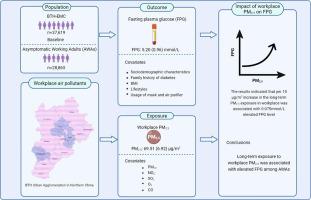Environment International ( IF 10.3 ) Pub Date : 2022-06-16 , DOI: 10.1016/j.envint.2022.107353 Jiangshan He 1 , Songhua Hu 2 , Ximing Xu 3 , Pei Guo 1 , Yujie Niu 4 , Jingbo Zhang 5 , Rong Zhang 4 , Shuo Chen 5 , Shitao Ma 4 , Feng Liu 5 , Qiang Li 5 , Chunjun Li 6 , Li Zhang 7 , Ying Wu 2 , Mianzhi Zhang 8 , Minying Zhang 1

|
Background
The impacts of long-term high exposure to PM2.5 in workplace on glucose metabolism in asymptomatic working adults (AWAs) have rarely been explored.
Objectives
To assess the relationship between long-term exposure to workplace PM2.5 and glucose metabolism in asymptomatic general working adults in heavily polluted regions.
Methods
We used the baseline data of the asymptomatic working participants from the Beijing-Tianjin-Hebei Medical Examination Cohort, which recruited adults undergoing medical examinations. A machine learning-based spatial–temporal model was used to estimate daily average PM2.5 concentrations in the participants’ workplaces. We assessed the association of long-term PM2.5 concentrations (three years prior to the interview) and fasting plasma glucose (FPG) using generalized linear mixed-effects models (GLMM) with inclusion of potential confounders. Stratified analyses by sex, age, BMI and smoking status, and two pollutant models were further performed.
Results
A total of 37,619 individuals were interviewed and 28,865 were included in the analyses. The mean FPG was 5.20 (0.96) mmol/L, and the estimated three-year average concentration of PM2.5 exposure was 69.51 (6.92) μg/m3. We detected a significant association of long-term exposure to workplace PM2.5 and FPG, a 10 µg/m3 increase in the long-term workplace PM2.5 exposure was associated with 0.075 (95%CI: 0.050–0.100) mmol/L elevated FPG and 25% (OR = 1.25, 95%CI: 1.05–1.50) elevated odds of abnormal fasting glucose metabolism with control of the potential confounding. The detected association between workplace PM2.5 and FPG metabolism remained significant in males, individuals aged > 44 years, overweight and/or obese people, both smokers and non-smokers, and when NO2, SO2, O3, and CO were included in the model.
Conclusions
Long-term exposure to workplace PM2.5 was associated with elevated FPG and/or odds of abnormal glucose metabolism among AWAs. Male, middle-aged, overweight and/or obese AWAs were more susceptible to workplace PM2.5 regardless of smoking status.
中文翻译:

工作场所长期暴露于 PM2.5 与无症状成人空腹血糖的关系:华北地区的多中心研究
背景
很少有人探讨工作场所长期大量接触 PM 2.5对无症状工作成年人 (AWA) 葡萄糖代谢的影响。
目标
评估重度污染地区无症状普通工作成年人长期暴露于工作场所PM 2.5与糖代谢之间的关系。
方法
我们使用了京津冀体检队列中无症状工作人员的基线数据,该队列招募了接受体检的成年人。基于机器学习的时空模型用于估计参与者工作场所的每日平均 PM 2.5浓度。我们使用广义线性混合效应模型 (GLMM)评估了长期 PM 2.5浓度(采访前三年)与空腹血糖 (FPG) 的关联,并纳入了潜在的混杂因素。进一步按性别、年龄、体重指数和吸烟状况以及两种污染物模型进行分层分析。
结果
总共采访了 37,619 人,分析中纳入了 28,865 人。平均FPG为5.20(0.96)mmol/L,PM 2.5暴露的三年平均浓度估计为69.51(6.92)μg/m 3。我们检测到长期暴露于工作场所 PM 2.5和 FPG之间存在显着关联,长期工作场所 PM 2.5暴露增加10 µg/m 3与 0.075 (95%CI: 0.050–0.100) mmol/L 升高相关FPG 和 25%(OR = 1.25,95%CI:1.05–1.50)增加了空腹血糖代谢异常的几率,同时控制了潜在的混杂因素。检测到的工作场所 PM 2.5与 FPG 代谢之间的关联在男性、年龄 > 44 岁的个人、超重和/或肥胖者、吸烟者和非吸烟者中仍然显着,并且当 NO 2 、SO 2、O 3和CO 包括在内时在模型中。
结论
长期暴露于工作场所 PM 2.5与 AWA 中 FPG 升高和/或葡萄糖代谢异常的几率相关。无论吸烟状况如何,男性、中年、超重和/或肥胖 AWA 都更容易受到工作场所 PM 2.5的影响。











































 京公网安备 11010802027423号
京公网安备 11010802027423号